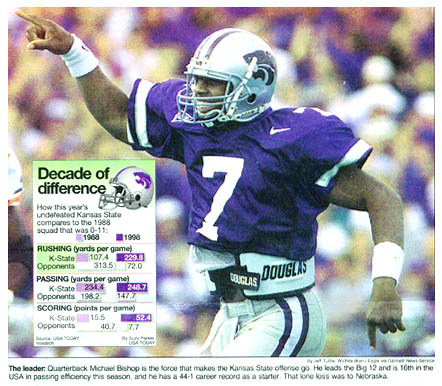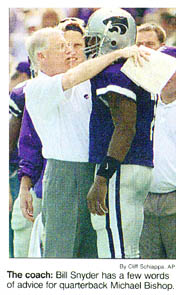
|
By Steve Wieberg MANHATTAN, Kan. -- They wondered about Kansas State's new president 12 years ago, about the bookish historian who flew in from Minnesota and immediately talked of shoring up the campus from one end to the other -- the woebegone football program included. More Rhodes scholars? A new art museum? Heads nodded. Those kinds of things might be realistic. But a competitive football team? Didn't Jon Wefald know? The Wildcats weren't just bad, they'd been an absolute purple-and-white embarrassment. For decades. They were hopeless, as a prominent alum sought to remind Wefald after a reach-for-the-stars speech to Kansas City Rotarians one day. "I said, 'Jon, I hate to be giving you advice unsolicited,"' recalls Rick Harman, a former Kansas State basketball star, one-time candidate for Kansas governor and now-retired restaurateur. "'But if you're going to talk about winning football, you're talking about needing a major earthquake to make it happen. You have a mountain to move.' " Today, Harman is in awe. Wefald -- and Bill Snyder -- moved it. Saturday, a program that once couldn't beat Northern Iowa and Austin Peay and that won only four of the last 55 times it took the field in the '80s, takes an unbeaten record and share of the No. 1 ranking into a showdown against Nebraska. It's a final frontier of sorts; Kansas State hasn't defeated the Cornhuskers in 30 years. But so complete is the transformation under Snyder, their workaholic, sweat-every-detail coach, that the Wildcats are 10-point favorites. Win and they could join Tennessee at the front of the race for a berth in the Fiesta Bowl and shot at the national championship. Repeat that. Carefully. A national championship. The promised land Wefald is a historian by training, but earthly historical analogies seem inadequate. "It's a story of almost biblical proportions," he says. "When you look at some of the miracles of the Old Testament ... I'd say it's very close to Moses parting the Red Sea."
Indeed, in a sport that has produced Rockne, the Gipper and the Bear, that has given us Army vs. Navy, Woody vs. Bo, Flutie-to-Phelan and a resurrected Northwestern in the Rose Bowl, this might be the Greatest Story Ever Told. "If these kinds of things don't happen," says Steve Miller, the former Kansas State athletic director who hired Snyder late in 1988, "then what do people dream about?" Truth to tell, by '88, most people at K-State had stopped dreaming. The Wildcats' program had essentially been dark since the Depression, finishing only five of the previous 54 seasons with a winning record and going winless eight times. It had produced an All-American, on average, every 18 years. The four seasons before Snyder's arrival were among the worst: a 4-40-1 record, outscored by an average of 43-13, not so much as an all-conference player the last three of those years. The nation was laughing. "We had nothing. Zero. No base at all," Wefald says. "There was no tradition. There were no facilities. There were maybe 10 or 12 major college players (at a time when the scholarship limit was 95). "I used to tell people, 'We're going to do everything we can to have a competitive football team. I'm an optimist, and I think we can do that.' And they'd say, 'He's new. He's from Minnesota, and he doesn't know what he's saying.' " But the school president backed up his words. Facilities were upgraded. Budgets expanded. Salaries rose. Those are standard props in a rebuilding story, though in Kansas State's case they're merely supportive. The single-most important piece in the puzzle was laid after an 0-11 finish in 1988, when a search for a new coach had stalled and associate athletic director Jim Epps brought up Snyder's name. Snyder had helped breathe life into programs at North Texas and Iowa. The offense he oversaw at Iowa was impressively balanced. And in an interview in his Iowa City home, he blew Miller away. Total control "He asked me, 'What's the commitment? Will you do this? Will you do that?' And I was on my heels the whole time," says Miller, now an executive with Nike. "I'm a pretty aggressive guy, and this guy's interviewing me. ... I left that place and said, 'He is the guy.' " Given that, and the fact that Snyder would have it no other way, Miller and Wefald handed him total control. In turn, Snyder gave Kansas State total dedication. Hundred-hour work weeks. Attention to every nook and cranny of the program, down to the margarine (not butter, and in pats instead of soft-whipped) served with pregame meals. "I think at a lot of institutions people would rather lose than lose control," Miller says. "To me, that is a fundamental mistake." "You say you're going to give him the money, you're going to give him the facilities, but you're not going to give him the authority and latitude? Without that, he only has part of the puzzle." With it, the Wildcats have steadily ascended. That's important, too. "The driving force," as Snyder says, "has been 'let's get better' " -- game by game, year by year. Kansas State managed five wins in his second season, went to a bowl in his fifth, hit the top 10 in his seventh and now is the school's first team to sit atop any poll since the 1959 basketball season. Behind versatile senior quarterback Michael Bishop, the Wildcats are the nation's highest-scoring team. The defense is ranked second-best. Maybe the Wildcats can't rewrite their sorry history, but they're leaving it behind. Most of today's players never heard the cruel jokes of the '80s, the references to Futility U. "I've been here since 1994," says offensive lineman Jeremy Martin, a fifth-year senior from the Kansas City area. "That's my history." Purple is now a passion. From a low of 9,336 season ticketholders in 1989, Kansas State is up to a record 36,000. Income from licensing and marketing, barely perceptible at $7,000 in the fate '80s, is projected at $600,000 - $700,000 this year. Wefald foresaw football as an inviting window to the university, and so it now is. Total donations are up 350% from 1986 levels, to $27 million. Enrollment has climbed from 15,000 to almost 21,000 (with an estimated 500 of that increase attributable to football, according to vice president John Fairman). Snyder, 59, has become a kind of patron saint to coaches of other downtrodden programs, who look to him in some cases for a rebuilding blueprint and most commonly for inspiration. "It gives every program, and every head coach trying to build a program from the ground up, a ray of hope," says Terry Shea, who is trying to do just that at Rutgers. "You look at what Kansas State has done, and you just marvel." Finishing the story Just one chapter in this Greatest Story remains unwritten, the one in which the Wildcats finally rise up and smite Nebraska. The Cornhuskers rolled past Kansas State 56-26 a year ago, much as they have every year since 1968. The average margin: 31 points. Snyder insists, "There's not a ballgame that's going to make or break this program. If we win, I think that's great. ... If we lose, it's not so great but life's going to go on." The feeling in these parts, however, is that this is The Team and The Time to ... ahem, part the Red Sea. That's Nebraska wearing red.
And Snyder wielding the staff.
|
